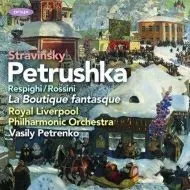
Rossini • Stravinsky Stravinsky: Petrushka (1911 version); Respighi/Rossini: La Boutique fantasque Royal Liverpool Philharmonic/Vasily Petrenko Onyx Classics ONYX4192 54:22 mins
Each of the Stravinsky ballets in Vasily Petrenko’s Royal Liverpool Philharmonic series has been matched to less than predictable repertoire, and perhaps this is the most surprising: from pre-war Ballets Russes to more Italocentric postwar potpourri in the form of Respighi taking mostly late Rossini rarities for another scenario involving dolls and puppets who come to life. Unfortunately this is the briefest of suite versions, compiled by Malcolm Sargent and missing some of the splendid links as well as the terrific fugal apotheosis. At 40 minutes the complete ballet score, for that matter, would have filled a disc which as it stands is quite short measure. It’s a shame because Petrenko has the idiosyncratic fun of a true ballet master with the ‘Mazurka’, ‘Cossack Dance’ and ‘Can-Can’, even if there’s a bit too much glissandoing about in what should be the bittersweet ‘Valse lente’.
Petrushka, though, remains the selling-point. If not quite the most vivid throughout, it too has original approaches – a clearly articulated speediness, in particular, to the beginning and end of the scene in the Moor’s room. There is also excellent continuity between the fairground dances, with a vivid intrusion from the bear and his shrill-piping master. Flute and cor anglais are characterful, trumpets and pianist slightly less so. It’s good to get the full glitter of the original 1911 version, not hugely different from the more often preferred 1947 revision, but the xylophone clatter and the occasional extra weight and snap of brass add spice. Natural if not ideally in-your-face sound, too.
David Nice